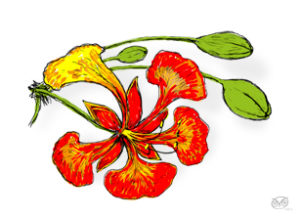
Al Qamar Academy, Chennai, Grade 3
27 July 2016, 12-1 pm
Small Science – Class 3
Chapter 1 – So many living things!
Nature walk and teacher thoughts
We went for a nature walk near a park in our colony. The park has lots of trees but the gate was shut, so we walked around the park fence and into some shady lanes nearby. Aneesa Aunty gave us clipboards and paper to write down what we saw.
Near the park, Aunty told us to be very quiet: just look around and listen. A hush fell over us. Suddenly we heard the clear, sweet sound of a bird – which bird could it be? Then the sharp sound of a squirrel. At first we did not see the squirrel but soon it popped out at the top of a tree. We also heard and saw some crows.
As we walked on the road, we carefully turned over a few stones on the side of the road to search for living things. Under the stones found many types of ants – tiny red-brown ants, small black ants and big black ants. Just as we had noticed last week in the school garden, the small black ants were carrying little oval-shaped white things: they may be the ants’ larva or pupa. The mud under the stones had roots. And many holes. At one place the ants had made an anthill under a large stone. They were going in and out through a hole.
We saw a small black bug – it had a fast, wiggly walk – Aneesa Aunty scooped it on to a piece of white paper. She showed us the sharp pincers at its back with which it could bite us – she later told us that this was an earwig. The earwig’s pincers were at its back. Near the stones we found a garden spider slowly moving its pincers – the spider’s pincers were near its mouth. We also saw a small brown worm which crawled away quickly. Aunty taught us how to replace the stones exactly as we had found them because under them were the animals’ homes.
We saw a cow too. And two dogs. And lovebirds in a cage hung in the verandah of a house. We saw a cat walking on the compound wall of that same house, then it jumped down on the other side.

Gulmohar flower and buds
This time we remembered that plants were also living things. There were many trees near the park. In some places there were red-orange and a few patterned petals lying on the ground. Aunty told us to look up and we saw the the Gulmohar tree laden with flowers, from which all those petals – and a few whole flowers – were falling. Under the Gulmohar tree Khadijah found a small green oval-shaped thing – she thought it was the seed. But Aunty opened it and showed us baby red petals – it was a bud. Ayan picked up a funny curly seedpod from under the acacia tree. Sarah found some small yellowish-green fruit. They were squishy. Aunty squished one and a seed popped out. She asked us to smell the squished pulp. Aha! It was the Neem fruit, and inside it a Neem seed. Khadijah said that they use Neem seeds for making medicines. Then we looked down and noticed, under the Neem tree there were a quite a few baby Neem plants, some very tiny, some as tall as us. Can you guess how these baby plants came there??
At one end of the park we saw a big Peepal tree and around its trunk and on some branches were wrapped stringy brown roots – growing on the trunk!! Roots! Outside! Never saw that before. Then on a building we saw a plant growing out of the wall. Khadijah thought that the people had planted it there in the crack – but that doesn’t make sense. Why would they do that? Wonder how did the plant start to grow in the wall??
Saleem saw a dosa below the fence on the low wall of the park. Like my mother puts food out for the animals, maybe someone put it there. The dosa is not a living thing. But there were living things growing on it – fungus, said Aunty. It looked like white dots on the dosa. Sometimes the bread at home also gets fungus. But that’s green and black. Then we saw the Pongam tree. Every single leaf of the Pongam tree had round whitish patches on it. Someone had told Aneesa Aunty that it is a kind of fungus which gets its food from the leaf. Under the patch the leaf looked all eaten up. But these patches were really not fungus. Aneesa and Jayashree Aunties later learnt the fascinating true story of the patches on Pongam leaves.
We saw some bunches of lovely fluffy cotton hanging down from a tall tree and found a bunch of cotton on the ground too. It felt soft and silky. With small black seeds in it. We took those seeds for our collection.
We came back to school quite tired but happy. We had seen so many living things.
In school we are germinating seeds on cotton wool. We observe them every day to see the changes – today the shoots looked bigger. The root has some small white hairy things on it. We don’t know if it is root hair or just bits of cotton wool.
Annnddd? Aunty told us we’d be going on a Tree Walk with Nizhal. Aaaaannnnd? to the Madras Crocodile Bank to see snakes, crocodiles and turtles.
Pedagogical Questions & Observations
- The Small Science program is focused not on facts, but on scientific skills and processes. Yet children love facts, and when they observe closely they ask many questions, wanting to know the answers right away! Most of their questions were like, “what tree (or flower / seed / insect / hole) is this?”. We must practice to use their questions to lead them to more investigations, and we too must go back and find out more.
- The skills of Small Science:
a) Grade 3 – Observation, expression, some writing, counting, design, drawing
b) Grade 4 – Observation, experimentation, recording results, inference, some math / graphing / analysis skills
c) Grade 5 – All of the above at a higher / more rigorous level - Starting with ‘observation’, it’s a good questions whose voice is heard – the child’s voice yelling, “Aunty come look what I found!” or the adult’s, summoning the children to observe something. Children are so excited during the walk, that it’s hard to find a happy medium.
- The tree walk outside the school was easy as our Al Qamar Grade 3 class runs with just 10 children, and we were four teachers. What would we do in a larger class? Even in this small group, in order to do justice to all their questions, and to stretch their own thoughts and observations further, we need time / deft class management / skillful teaching / continuous updating.
- We later read out the description of the nature walk to the Class. The children enjoyed recalling and talking more about what all they had seen a few days earlier. Perhaps it will help with their writing in the workbook.
Aneesa Jamal
Correspondent, AQA
Jayashree Ramadas
Visitor from HBCSE



